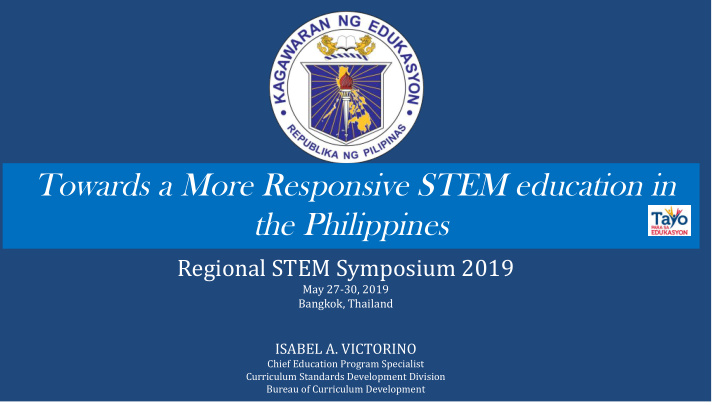



Towards a More Responsive STEM education in the Philippines Regional STEM Symposium 2019 May 27-30, 2019 Bangkok, Thailand ISABEL A. VICTORINO Chief Education Program Specialist Curriculum Standards Development Division Bureau of Curriculum Development
Presentation Outline General Information STEM Curriculum K TO 12 Curriculum Teacher Training Programs Department of Education-Bureau of Curriculum Development BUREAU OF CURRICULUM DEVELOPMENT
GENERAL INFORMATION • English and • 27,841,522 • English • 100.98 M Filipino learners (as of August 2015) • Mother tongue (K-G3 K to 12 Main Language Foreign Language Population Size Population of Instruction taught • Grades 1-6 • Grades 1-6 • Kindergarten = 1 • 1:29 (97%) (97%) (Elementary) • Elementary = 1 • Grades 7-10 • Grades 7-10 • 1:25 (JHS) • JHS = 1.11 (89%) (89%) • 1:29 (SHS) • SHS = 1.33 Schooling Gender Teacher- Completion rate survival rate (K to Parity Index student ratio of students 12) Department of Education-Bureau of Curriculum Development BUREAU OF CURRICULUM DEVELOPMENT
STEM Curriculum Ø STEM is part of the Academic Track in SHS à STEM strand Ø Special Science Schools à emphasis on Science, Math, and Research Ø Recent Curriculum Innovation: K to 12 ü Curriculum in 2012 Department of Education-Bureau of Curriculum Development BUREAU OF CURRICULUM DEVELOPMENT
K to 12 Curriculum Ø The K to 12 framework shows emphasis on the 21 st Century Skills incorporated in the Curriculum of the different learning areas. Brain-based learning Department of Education-Bureau of Curriculum Development BUREAU OF CURRICULUM DEVELOPMENT
Teacher Training Programs •Elementary •100% •21% (SHS (484,406) STEM teachers) •JHS (268,527) •SHS (55,156) % of teachers % of teachers Total number of with a Bachelor’s teaching at least teachers Degree 1 STEM Subject Department of Education-Bureau of Curriculum Development BUREAU OF CURRICULUM DEVELOPMENT
Teacher Training Programs Weaknesses: Strengths: Ø Not all teachers are trained Ø Teachers are capacitated Ø Limited number of training Ø There is an allotted budget for days the training programs Ø Focus on both content and pedagogy Ø Proper coordination with implementing schools Ø Strong partnership with TEIs Department of Education-Bureau of Curriculum Development
Preparing Teachers to Teach STEM Challenges and Issues Interventions • Upgrade professional • Delivery of the lesson is development of STEM perceived to be an obstacle for Teachers STEM teachers • Increase training days • Limited capacity building programs for STEM teachers • Provide bigger budget for STEM • Insufficient Science and Mathematics Equipment and • Close the gaps in laboratories Learning Resources and workshop Department of Education-Bureau of Curriculum Development BUREAU OF CURRICULUM DEVELOPMENT
Current Initiatives HEI Initiatives: ü Philippine Normal University (PNU) conducted a Philippine Education STEM Pipeline Study (funded by DepEd Partnerships: USAid and PBED) à once published, the study could provide insights on the state of STEM education in the country ü UNILAB Foundation Ø STEM+PH Ø HEADS UP PH ü The University of the Philippines College of Education Ø IDEAS POSITIVE houses the Center for Integrated STEM Education in the Philippines (CISTEM) that aims to strengthen inclusive ü Nanyang Polytechnic STEM education through ü Philippine Nuclear Research • capacity building for teachers and educational Institute (PNRI) C I STEM I institutions Center for Integrated STEM Education in the Philippines • curricular innovations • maximized network linkages • learner empowerment Department of Education-Bureau of Curriculum Development
Ways Forward • Meaningful ICT-based innovation for quality Science learning and teaching • Increase number of Science High Schools in the country • Robotics in the Science Curriculum • Regional Science Research Centers in the different regions of the country • STEMS Hubs Department of Education-Bureau of Curriculum Development
Recommend
More recommend